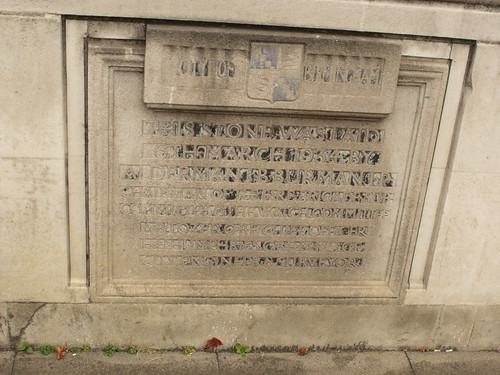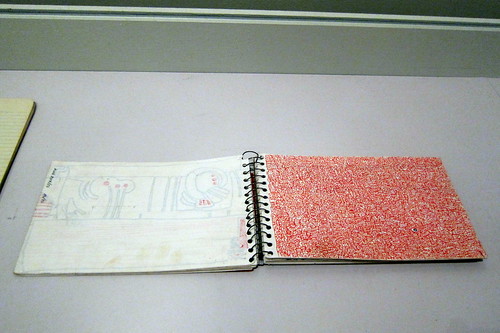Former West Midlands Fire Service Headquarters building - foundation stone
Image by ell brown
This is the former West Midlands Fire Service Headquarters building at Lancaster Circus Queensway and Aston Street (is also near James Watt Queensway).
There are plans to turn it into student accommodation and to build a tower here.
Foundation stone on the ex fire station. Bit hard to read, but it was laid in 1934.
Former Birmingham Central Fire Station
It was built in the 1930s.
Is Grade II listed - West Midlands Fire Service Headquarters - British Listed Buildings
Fire Service Headquarters. 1935. Herbert Humphries and Herbert J. Manzoni. Red Flemish bond with Portland stone and concrete dressings with a pantile roof. Three storeys with attics and basement. The building is triangular with ranges set around a central drill yard and faces onto three streets; Corporation Street, Aston Street and New Street. The Fire Service Headquarters was designed to house an enclosed community for the fire-fighters, their families and the senior officers. It included housing, a school room and roof top playground, and recreation rooms, with garaging for the fire engines, workshops and stores for their repair. The style is Neo-Georgian to the exterior and functional or 'Moderne' to the courtyard fronts and the tall hose tower at the eastern corner of the yard.
HISTORY: The building was designed as the New Central Fire Station for the City of Birmingham. The design was by Herbert Humphries [later Sir Herbert Humphries] and completed by Herbert Manzoni after Humphries' retirement in 1935. It was built on a site which was already built over and a tavern, the City Weights and Measures Department and a row of houses had to be demolished to clear the site of c. 8,000 square yards. By October 1930 the site had been cleared, but the foundation stone for the new building was not laid until March 1934. The building was finished by December 1935 at a cost of £157,000 and officially opened by the Duke of Kent. Contemporary accounts reflect the high degree of civic pride which the building provoked and it is described in glowing articles which spoke of its advanced technology. This new technology included lights to indicate which machines were to respond to a fire, loud speakers to identify the location of the fire and electronically controlled engine starting and door opening. It also featured the latest 'turntable escape' which was reputed to be the first of its kind in the country.
The overall plan gives rich insight into the functioning and aspirations of the fire service at that time, prior to its nationalisation in 1941.
housing-GBD
Image by DCF_pics
The GBD art installation
THE CHINESE DREAM architectural research project Beijing : burb.tv
Dynamic City Foundation
Brooklyn - Brooklyn Museum: Keith Haring: 1978–1982 - Journal design
Image by wallyg
Journal Design, 1977
Courtesy of Keith Haring Foundation
Keith Haring: 1978–1982, on display from March 16 to July 8, 2012 in the Morris A. and Meyer Schapiro Wing of the Brooklyn Museum, was the first large-scale exhibition to explore the early career of the artist. Curated by Raphaela Platow, the exhibition includes 155 works on paper, numerous experimental videos, and over 150 archival objects, including rarely seen sketchbooks, journals, exhibition flyers, posters, subway drawings, and documentary photographs.
Keith Haring (May 4, 1958 – February 16, 1990), a Pennsylvania native, moved to New York in 1978 and with his trademark creations across a variety of media, quickly made his mark in the thriving alternative art community that was developing outside the gallery and museum system. Haring was known for his subway graffiti, but instead of painting subway cars with spraypaint, he mostly drew with white chalk on the black paper pasted on unused advertising spaces. His distinctive style became widely known by those who never knew his identity. In his later years, he took on a more activist role, contributing works to hospitals and charities. In 1989, after being diagnosed with AIDS, he founded the Keith Haring Foundation, which supports organizations involved in AIDS education and outreach.
The Brooklyn Museum, sitting at the border of Prospect Heights and Crown Heights near Prospect Park, is the second largest art museum in New York City. Opened in 1897 under the leadership of Brooklyn Institute of Arts and Sciences president John B. Woodward, the 560,000-square foot, Beaux-Arts building houses a permanent collection including more than one-and-a-half million objects, from ancient Egyptian masterpieces to contemporary art.
No comments:
Post a Comment